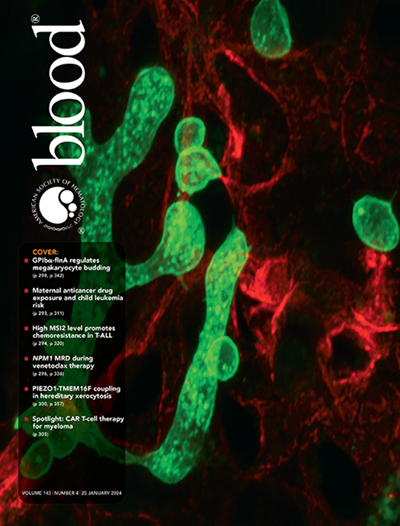Genetic iron overload aggravates and pharmacological iron restriction improves MDS pathophysiology in a preclinical study.
IF 21
1区 医学
Q1 HEMATOLOGY
引用次数: 0
Abstract
Although iron overload is a common feature in myelodysplastic syndromes (MDS), it remains unclear how iron excess is detrimental for disease pathophysiology. Taking advantage of complementary approaches, we analyzed the impact of iron overload and restriction achieved through genetic activation (FPNC326S) and pharmacologic inhibition (vamifeport) of the iron exporter ferroportin in a MDS mouse model, respectively. While FPNC326S-induced iron overload did not significantly improve the late stages of erythroid maturation, vamifeport-mediated iron restriction ameliorated anemia and red blood cell maturation in MDS mice, through the reduction of oxidative stress and apoptosis in erythroid progenitors. Iron overload aggravated and restriction alleviated ROS formation, DNA damage and cell death in hematopoietic stem and progenitor cells, resulting in altered cell survival and quality. Finally, myeloid bias, indicated by expanded bone marrow myeloid progenitors and circulating immature myeloid blasts, was exacerbated by iron excess and attenuated by iron restriction. Overall, vamifeport treatment resulted in improved anemia and significant survival increment in MDS mice. Interestingly, the combined therapy with vamifeport and the erythroid maturation agent luspatercept has superior effect in improving anemia and myeloid bias as compared to single treatments, and offers additive beneficial effects in MDS. Our results prove for the first time in a preclinical model that iron plays a pathologic role in transfusion-independent MDS. This is likely aggravated by transfusional iron overload, as suggested by observations in the FPNC326SMDS model. Ultimately, the beneficial effects of pharmacologic FPN inhibition uncovers the therapeutic potential of early prevention of iron toxicity in transfusion-independent MDS.在一项临床前研究中,遗传性铁超载会加重 MDS 的病理生理学,而药物限铁则会改善 MDS 的病理生理学。
虽然铁超载是骨髓增生异常综合征(MDS)的常见特征,但铁过量如何对疾病的病理生理学产生不利影响仍不清楚。利用互补方法的优势,我们分析了铁超载的影响,以及通过基因激活(FPNC326S)和药物抑制(vamifeport)铁输出蛋白分别对MDS小鼠模型产生的限制。FPNC326S诱导的铁超载并没有明显改善红细胞成熟的后期阶段,而vamifeport介导的铁限制则通过减少红细胞祖细胞的氧化应激和凋亡,改善了MDS小鼠的贫血和红细胞成熟。铁超载加剧了造血干细胞和祖细胞的 ROS 形成、DNA 损伤和细胞死亡,而限铁则减轻了这些现象,从而改变了细胞的存活率和质量。最后,骨髓偏向(表现为骨髓髓系祖细胞和循环中的未成熟髓系胚泡增大)因铁过量而加剧,因铁限制而减弱。总体而言,伐米磷治疗可改善贫血,并显著提高 MDS 小鼠的存活率。有趣的是,与单一疗法相比,瓦米波尔特和红细胞成熟剂路司帕特罗联合疗法在改善贫血和骨髓偏倚方面效果更佳,并对MDS具有相加的益处。我们的研究结果首次在临床前模型中证明,铁在输血无关的 MDS 中起着病理作用。正如在 FPNC326SMDS 模型中观察到的那样,输血铁超载可能会加重病情。最终,药物抑制 FPN 的有益效果揭示了早期预防输血无关型 MDS 中铁毒性的治疗潜力。
本文章由计算机程序翻译,如有差异,请以英文原文为准。
求助全文
约1分钟内获得全文
求助全文
来源期刊

Blood
医学-血液学
CiteScore
23.60
自引率
3.90%
发文量
955
审稿时长
1 months
期刊介绍:
Blood, the official journal of the American Society of Hematology, published online and in print, provides an international forum for the publication of original articles describing basic laboratory, translational, and clinical investigations in hematology. Primary research articles will be published under the following scientific categories: Clinical Trials and Observations; Gene Therapy; Hematopoiesis and Stem Cells; Immunobiology and Immunotherapy scope; Myeloid Neoplasia; Lymphoid Neoplasia; Phagocytes, Granulocytes and Myelopoiesis; Platelets and Thrombopoiesis; Red Cells, Iron and Erythropoiesis; Thrombosis and Hemostasis; Transfusion Medicine; Transplantation; and Vascular Biology. Papers can be listed under more than one category as appropriate.
 求助内容:
求助内容: 应助结果提醒方式:
应助结果提醒方式:


